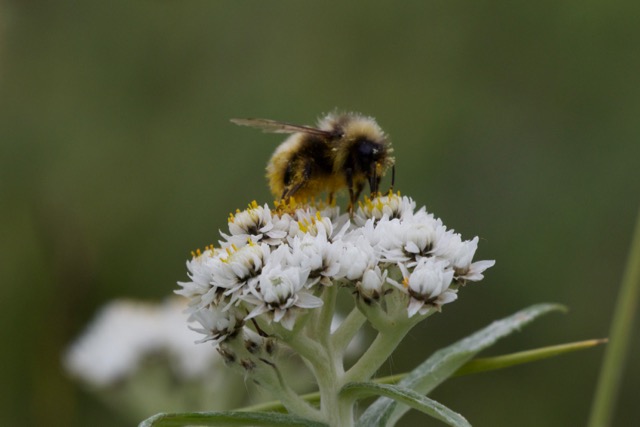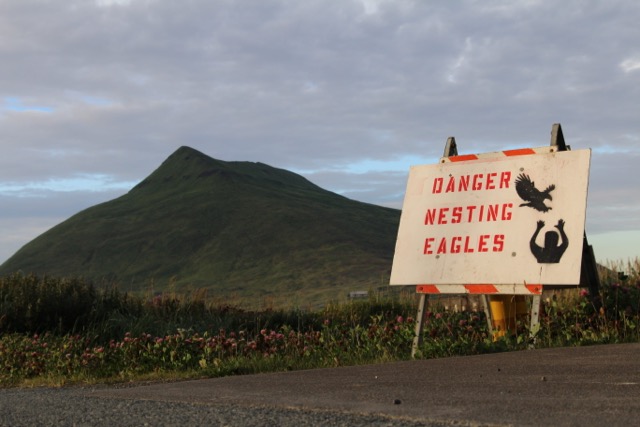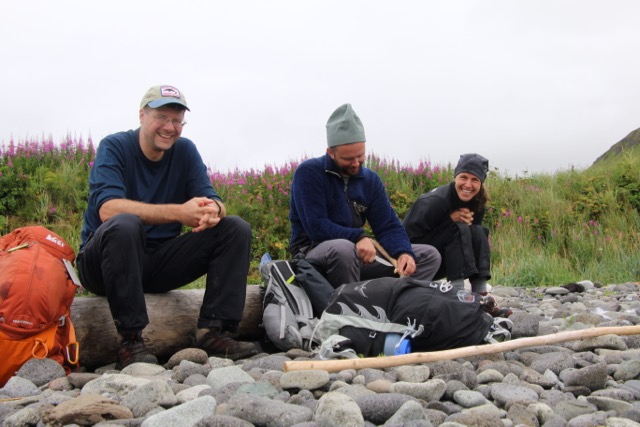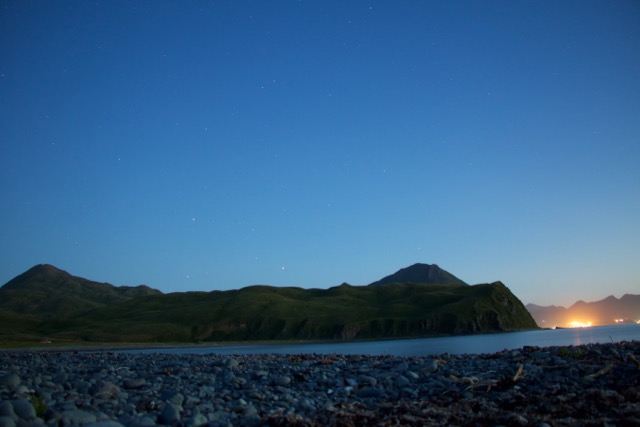4 August 2016.
Yesterday we had another successful and breathtaking day collecting monkeyflowers in Unalaska. Here are some pictures, including some bees pollinating flowers in the Aleutians.

4 August 2016.
Yesterday we had another successful and breathtaking day collecting monkeyflowers in Unalaska. Here are some pictures, including some bees pollinating flowers in the Aleutians.
Talking with a friend about hiking in Alaska and realized I'd never posted this particular day of the mimulus adventure. Words are excerpted from a forthcoming story of same. #natgeo #expedition #AleutianHiking #botanizing https://t.co/NAJWFnqXxQ pic.twitter.com/mynzHKkyvm
— Roger Topp (@rmtopp) July 31, 2018
10-11 August 2016.
I spent today looking for flowers and driving back to Anchorage. I found a couple more populations, and stopped for a large pizza on a restaurant by the road. It tasted delicious! On the way I stopped in the Kenai River, and in some smaller tributaries. The creeks were full with sockeye salmon. In those places of easy access, fishermen were having a field day. I wondered if intense fishing competes with wildlife that relies in the salmon runs. The fishing of salmon in Alaska I supposed to be regulated, but I suspect the fishing quotas are seldom enforced. There are too many fishermen and too few park rangers.
Now I am at the airport, waiting for my last connection back to Scotland. I am excited to go back to my family, and can’t wait to see my wife and two-year old after three weeks away.
The trip has been amazing. I learned lots, met great people, and saw monkeyflowers in their natural habitat for the first time. Alaska has captured my imagination once again. And the Aleutians have been as exciting as I expected and more. Now the second part of the project can begin. Using thousands of genetic markers we will attempt the first world-wide analysis of monkeyflowers. The samples we collected in the Aleutians and the rest of Alaska will be studied alongside with other samples from western North America, Europe, the Faroes and New Zealand. We hope our study will help understanding how species adapt to new environments, and throw some light into the origins of a little yellow-flowered plant that was collected more than 200 years ago in a Russian expedition to Alaska.
9 August 2016.
I woke up at 5:00am to pick up camp and drive to the ferry terminal in Valdez. The ferry took me across Prince William Sound to the port of Whittier. In the sound I saw my first orca whale! The fog and cloud accompanied us most of the way.
Whittier is a strange place built in secret by the army in WWII. The only way out of the port by road is through a long tunnel through the heart of the mountain. The single lane tunnel changes direction every half hour to allow traffic both ways. Coming out of the tunnel I was received by Portage Glacier and finally some clear and sunny skies.
Near one of the mountain passes, within the Chuchach National Forest I found more Mimulus, again different from what I saw in Valdez. I kept driving into Kenai with the aim of reaching Homer that night. It was a good drive with lots of mountains, glaciers and the incredible Kenai River full of salmon fishermen. Around 8pm I reached Homer in clear skies. The port town is framed by snowy mountains and glaciers. In the spit, an eclectic mix of people and wildlife hung out together. A couple came out of a grounded boat turned into a house. The beach was full with RVs and tents. Near the shore, some seals or sea lions hung out not far from the fisherman on the other side of the spit. This is my last night in Alaska.
8 August 2016.
After two days searching I found Mimulus today. Along a salmon stream a few plants poked their fruity and flowery heads through the grass. A couple of people were mesmerized by seeing the salmon swim upstream to find a place to lay their eggs, but I was too excited to find monkeyflowers here. The National Park ranger (Bonnie) looked at me amused and happy to have helped to find the plant.
There were only a few plants, but they were enough for spurring me into keep looking. About 20 miles from Valdez I found more plants and up the road a few more. Success!
As I was pulling out from one of the sampling sites I noticed a tire had gone completely flat. I changed the tire on the side of the road and found a metal hook deep into the broken tire. A few hours later I had driven back to Valdez and repaired the tire. I collected a few more populations at increasing elevation. These plants are different to the other ones we have seen in the trip. There is a most interesting phenotype here that I have not seen anywhere else. I’ll have to look more carefully at these plants when I get back to Scotland.
7 August 2016.
Today I drive from Glenallen to Chitina. Chitina is the gateway to the Wrangell-St. Elias National Park. The park is enormous: the size of Switzerland or about several Yellowstones. It is also one of the coldest places on Earth. But is an amazing region, beautiful and remote. I barely scratch the surface as venturing into the park is an adventure on its own, and not something that could be attempted fully in a couple of days. One of the park guards tells me about a pilot who has been flying over the park for 20 years and reckons he only knows about a fifth of it.
After Chitina the highway becomes a gravel road. The park guard at Chitina suggests not to attempt it without a full-sized spare tire. The rental doesn’t have one (just a small tire version which they call a donut). Apparently the main risk of driving there is not potholes, but into the rusty rails that were left behind when they converted the old rail line into a road. Being there I cannot resist, and decide to drive anyway. I just need to get into the park itself. The weather looks foul, and after 15 miles I reach an old bridge crossing an enormous gorge. The Kuskulana Bridge was built in 1910 to allow trains to transport the mineral riches extracted from the Kennicott and McCarthy Mines, sixty miles from Chitina. It takes me a long time to get to the bridge as the roads are rough, and I am wary of not puncturing a tire. Along the way I see a red fox, an eagle, and some ptarmigans. The place is amazing!
But instead of camping in the Park, I decide to aim for Valdez where I need to catch a ferry on the 9th.
On the road I see a very terrible accident that happened just ahead of me. I see a cloud of smoke raise in the curve ahead, and as I turn, I see the crash between an RV and a tourist bus. The RV is in the middle of the road, but the bus has gone on to smash on a hill on the roadside. People are badly hurt and I stop to help. Some people are jumping out of the windows of the bus. The RV has the front destroyed and the people there are still trapped inside. A dog in the front seat howls. It makes me terribly sad but I cannot do much. The police arrive soon after and I leave. I thinkk of the poor people and their families that are ending their Alaskan trip in such a way. I’m sorry for them.
I continue driving towards Valdez, and in the evening I see Whorthington glacier and approach it to almost touch it. The glacier is dreary in the cold rain, yet beautiful. The ice of a glacier seems to always shine of a special blue colour. Then I drive through Thompson Pass, and can almost see the peaks of the mountains behind the thick fog and cloud. In Valdez, the city has been completely covered with fog. But now and then I glimpse the Valdez glacier and the amazing mountains. It is rainy and cold. And for the second day I have not seen any monkeyflowers. As this bleak day ends, I set up my camp near the glacier.
6 August 2016.
The 6th of August was our last day in Unalaska. Jannice and I managed to resample one of the populations (UNA) to get the seed that was unripe when we saw it in the first day. It was a rush through the Overland Pass to Summer Bay in a cold and foggy morning. We found a few plants with seed and headed back to the hotel to check out and pick up Josh. The small plane at the airport arrived soon before our departure, exchanging passengers between Anchorage and Dutch Harbor.
At Anchorage we part ways. Jannice and Josh head back home, and I will stay a few more days to try sampling monkeyflowers in mainland Alaska. These populations will be useful as markers to compare against the monkeyflowers of the islands (Kodiak and the Aleutians) and Alaskan Peninsula. If our hunch is correct, the Scottish monkeyflowers should group closer to the Aleutian and Kodiak samples than to the ones I hope to find in mainland Alaska. But finding Mimulus in mainland Alaska is harder. They may not be as common as in the coast and islands further west.
After picking up a rental SUV I drive for a few hours east on the Glenn Highway. After passing the town of Palmer two mountain ranges rise up: the coastal mountains in the south and the interior mountains in the north. The road follows more or less the Matansuka River, and soon I read the glacier of the same name. The landscape is impressive. Unlike treeless Unalaska, the mountains here are forested. The glacier snakes down the valley reaching the river plain. Soon after a new range of mountains rises up in the north. These mountains are made of gypsum, coloured red in the evening light. The gypsum of these red mountains is witness of the volcanic activity that shapes Alaska. Around eight or nine in the evening I decided to stop and set camp. I find a campsite in Glenallen, a small roadside town that has few attractions except its beautiful surroundings. I fall asleep among the sound or rain and strong winds. For the next days, Alaska has decided to release some wet and rough weather to make the monkeyflower search more interesting.

5 August 2016.
This is our last full day in Unalaska. It is hard to resist the temptation to continue exploring the island, but today we must prepare and sort the material we have collected in nearly two weeks of the expedition. We set a working lab in the Grand Aleutian Hotel and begin sorting through hundreds of plant samples. The seeds are divided in three lots. The seeds collected here will fuel research in labs in North America and Europe. Who knows which of these populations we have sampled will hold unexpected secrets beyond the goals of this research trip. Josh and Jannice take hundreds of seeds to their labs, and I will transport the remaining of the seed material, leaves stored in silica gel, and herbarium specimens.
The herbarium specimens are prepared and pressed between sheets of newspaper, porous paper, and cardboard. The black straps of the wooden press, hold and squeeze the pants dry. The resulting flattened plants will lose some of their colours.
But their essence will be maintained in this dried form.
Once prepared a herbarium specimen can last hundreds of years; Darwin’s herbarium specimens can still be seen in the Natural History Museum in London. The plants we are collecting in this trip will be deposited in Herbaria in Fairbanks and Edinburgh. A herbarium is a plant museum that serves both as a record of plant life across time and as a source for teaching and research. No matter how many notes you take in the field, or how many photos you shoot, despite all the genetic analyses you may perform, nothing will replace the dried plant pressed between old newspaper sheets. Details of the morphology that were overlooked, characteristics that define a population or even a species are preserved in this herbarium. And herbarium specimens can now also be used as repositories of genomic information. Using genetic tools similar to the ones used to study DNA in ancient human and animal bones, one can extract entire plant genomes from herbarium plants. Thus an herbarium is not only an individual plant preserved dried in a museum for arcane research. It also holds plants across different time points (from Linnaeus to nowadays) and becomes an ark of biological material, both morphological and genetic, which will allow future researchers to study how life continues changing and adapting through time.
By the end of the day we have finished preparing the material. The room is quite and seed envelopes, silica gel, plastic bags, and boxes lay all over the place. The three of us are satisfied and happy to have found and collected Mimulus in this amazing trip. Since we started the trip we have sampled more than 20 populations. Not bad. Not bad at all.
In the evening, we stopped by Suzi’s house to drop off the leftover gas canisters and supplies, and to return her walking stick and leave one more that Josh carved in the fire. I take the chance to shoot a few more photos of the Orthodox Cathedral. The thought crosses my mind that I never had the chance to pass the regards from Father Methodious to the Unalaskan priest, Father Ivan. The fireweed (Chamaerion angustifolium) puts out its best display of pink flowers outside the Cathedral. In the river opposite to the road, the salmon struggle against the current, their back breaking the water, and sploshing across the stream.
As a farewell night, and invited by the volcanologists that we met at the hotel a few days ago we head to the local bar (the ones that travel by helicopter and who kindly have spotted monkeyflowers in other parts of the island for us).
The bar is called The Norwegian Rat.
A wooden house near the water, surrounded by crab traps and wooden pallets, and a WWI bunker in the corner outside. Josh decides not to join in, and Jannice and I head to the rathole, a bit uncertain of what the heir of the Elbow Room may hold for us. (The Elbow Room was an infamous and rowdy bar in Unalaska, but is now closed. The closure brought infinite happiness to Suzi Golodoff who happened to live next door to it, and had to endure loudness and drunks for many years). As we walk in a sign requests closing the door immediately to avoid being taken out of its hinges due to strong winds. I wonder if this is a code phrase to keep The Rat isolated from the outside. Inside, there are a few pool tables, a shuffle board, and a well-stocked bar… with stuffed animals and pelts hanging from the ceiling. The night was full of encounters with local characters and a few other scientists. Although it is hard to tell who is really local. The best Jannice and I could do is to look at their shoes. Brown rubber boots of a specific brand seems to be a unifying character of who we thing are locals. At The Rat we met Kurt a fisherman, who was having the “happiest nigh of his life”. Theo, a bush pilot who has just come from the Pribiloff Islands, two ex-marines who are doing some surveying of the Bristol Bay with a large crew of geoscientists, a large and drunk Unalaskan who enjoys throwing pallets into the open fire pit until an even larger barman comes to tell him off, Amy or Annie and his local friend who are gracious about us accidentally knocking their beer on the floor. In just a couple hours, The Rat gives us a small taste of what nightlife in a place like Unalaska may be. Boring is not.

2, 3 August 2016.
I am having breakfast looking out of the hotel window. About 100m from here a seaplane sits in the calm waters, waiting to be sprung into action. The seaplane is a herring spotter, used by fishermen to help them locate schools of fish while at sea. Fishing in the Aleutians needs diverse strategies.
The second of August was a relaxed day. In the morning we picked up camp and came back to Unalaska. The weather was wet and a bit windy, and the chill slowed us down a bit. When we were ready to go it was too late to attempt a long hike given the weather conditions. Instead, we decided to explore the World War II embattlements in Mount Ballyhoo. Ballyhoo lies behind Dutch Harbor. The conical mountain that we climbed the first day is also the place where the Americans hurriedly built military defenses to protect Unalaska. After the bombing of Unalaska, local people were evacuated to the mainland, and the only residents left here were soldiers, digging trenches, building bunkers, and mounting guns and cannons into the cliffs overlooking the bay of Unalaska. When the locals were evacuated by the army they were not allowed to transport more than what they could carry in a small suitcase. When they were allowed to return years later, people have lost much, their houses and churches emptied and ransacked by opportunists. Today what remains of that dark time are the abandoned war buildings that spill in all directions into the island.
In the bunkers in the cliffs of Ballyhoo, the concrete walls were covered by the graffiti of subsequent visitors. The doors were broken and fallen, or gone altogether. Cables hung from the flat roofs, and a few structures collapsed under the weight of the earth used to hide them from Japanese attacks.
In the gray and rainy day, the place had an eerie feeling to it, and we walked among the ruins in silence.
Among the cracked walls and floors, I found a very special plant: Arabidopsis kamchatica. Arabidopsis kamchatica is related to the model plant species thalecress (A. thaliana), and has a complicated family history. A. kamchatica originated through hybridization between two species, followed by one of the most significant mutations in nature: the doubling of the entire amount of DNA in their cells, a phenomenon called polyploidisation. Genome doubling, or polyploidy, has had a massive influence in the evolutionary history of plants, and it is one of the topics I study in my lab. It is the same process that produced the Scottish monkeyflower I discovered a few years ago (Mimulus peregrinus). I was glad to see a more ancient polyploid, A. kamchatica, growing in Unalaska. Labs around the world, including Diana Wolf’s in Fairbanks and Kentaro Shimizu in Zurich, have been studying this little plant for years. I hope to be able to help their research projects with our observations and collections of A. kamchatika in the Aleutians.
On the 3rd of August, we explored Peace of Mind Trail, which reaches Beaver Inlet, one cove away from Ugadaga Bay. It was a great hike. We collected Mimulus in waterfalls and lakes. When we reached the beach, an inquisitive red fox watched us from the rocks on the beach. We had lunch on a log brought to the sand by the ocean drift. A young bald eagle kept jealous watch on us, wondering why had we taken her favourite spot. In the afternoon, we met Suzi for dinner. We exchanged stories, and ate fresh seafood brought by the fishermen of Dutch Harbor.

1 August 2016.
In 1805, Grigori von Langsdorff, a naturalist travelling with a Russian expedition, reached the island of Unalaska. Welcomed by the Unangan people that approached their ship in baidarkas (kayaks), Langsdorff and some of the crew crossed Beaver Inlet and reached the shore in Ugadaga Bay. Along the way, Langsdorff discovered two new plant species, and one of them would eventually spread as far as Scotland and New Zealand.
Today, we traced back the steps of Langsdorff in search of the plant he discovered 211 years ago: the yellow monkeyflower Mimulus guttatus.
As we descended into Ugadaga bay, the Aleutians gave us a spectacular and very rare welcome. A cloudless, bright blue sky highlighted the intense green of the vegetation. The green mountains were only interrupted occasionally by rock screes and a few snow patches resisting the summer.
In the narrow and steep gorge cut by the stream crossing the valley, we found the first monkeyflowers. A few scattered plants hanging on the banks, and blooming profusely with yellow fury. Finding this plants is the culmination of our National Geographic expedition to the Aleutians.
It was easy to be thrilled and moved realising that we had found Langsdorff’s plants and walked the same ancient trail that he took to reach the village of Iliuliuk two centuries before.
As we descended onto the pebble beach, we saw and collected more monkeyflowers. We sat on the beach and dipped our toes in a salmon river at the south end of the bay. The Alaskan sun shone unimpeded by clouds. As we watched salmon in the river and bald eagles soaring above us I imagined the sense of discovery that Langsdorff must have felt as he travelled through the Aleutians.
In the afternoon, we set camp in Morris Cove and talked and watched the sun set in a sea teaming with sea otters and Steller sea lions. At midnight, after the sky finally darkened, the salmon approach the beach, jumping in search of the fresh water creek.